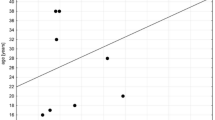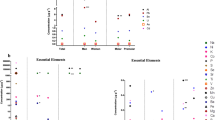Abstract
The result of exposure to Pb is its accumulation in mineralized tissues. In human body, they constitute a reservoir of approx. 90 % of the Pb reserve. The conducted research aimed at determining the accumulation of Pb in calcified tissues of permanent teeth. The concentration of Pb in 390 samples of teeth taken from a selected group of Polish people was determined using the AAS method. Average concentration of Pb in teeth amounted to 14.3 ± 8.18 μg/g, range of changes: 2.21–54.8 μgPb/g. Accumulation of Pb in human body was determined based on changes in Pb concentration in teeth of subjects aged 13–84 years. It was found that in calcified tissues of teeth, the increase in concentration of Pb that occurs with age is a statistically significant process (p = 0.02, the ANOVA Kruskal–Wallis test). It was determined that the annual increase in concentration of Pb in tissues of teeth is approx. 0.1 μg/g. Moreover, a different course of changes in Pb concentration in tissues of teeth in people born in different years was observed. The level of Pb concentration in teeth of the oldest subjects (>60 years) decreased for those born in the 1930s compared to those in the 1950s. Teeth from younger persons (<60 years) were characterized by an increasing level of Pb concentration. The analysis of changes of Pb indicates that for low exposure, a relatively greater accumulation of Pb concentration in calcified tissues of teeth can occur.



Similar content being viewed by others
References
Sen IS, Bernhard PE (2012) Anthropogenic disturbance of element cycles at the Earth's surface. Environ Sci Technol 16(46):8601–8609
Liang J, Mao J (2015) Source analysis of global anthropogenic lead emissions: their quantities and species. Environ Sci Pollut Res 22(9):7129–7138. doi:10.1007/s11356-014-3878-4
Gad SC, Pham T (2014) Lead. In: Wexler P (ed) Encyclopedia of toxicology, 3rd edn. US National Library of Medicine, Bethseda, MD, USA: Elsevier INC, 61–65
http://www.shell.com/global/products-services/solutions-for-businesses/aviation/shell-aviation-fuels/fuels/types/avgas.html%23textwithimage_6. Accessed 22 september 2015
http://www.orlen.pl/PL/DlaBiznesu/Paliwa-lotnicze/Documents/karta_charaktarystyki_avgas_100ll.pdf. (in Polish) Accessed 15 september 2015
Advance notice of proposed rulemaking on lead emission from piston-engine aircraft using leaded aviation gasoline (2010) United States Environmental Protection Agency. 75: 22440–68
Miranda ML, Anthopolos R, Hastings D (2011) A geospatial analysis of the effects of aviation gasoline on childhood lead levels. Environ Health Perspect 119(10):1513–16
Vallascas E, De Micco A, Deiana F, Banni S, Sanna E (2013) Adipose tissue: another target organ for lead accumulation? A study on Sardinian children (Italy). Am J Hum Biol 25:789–794. doi:10.1002/ajhb.22448
Savery LC, Wise SS, Falank C, Wise J, Gianios C, Thompson WD, Perkins C, Zheng T, Zhu C (2014) Global assessment of oceanic lead pollution using sperm whales (Physeter macrocephalus) as an indicator species. Mar Pollut Bull 79:236–44
Persson BRR, Holm E (2014) (7)Be, (210)Pb, and (210)Po in the surface air from the Arctic to Antarctica. J Environ Radioact 138:364–74
Nie LH, Wright RO, Hussain J, Amaraisriwardena C, Chettle DR, Pejovic-Milic A, Woolf A, Shannon M (2011) Blood lead levels and cumulative blood lead index (CBLI) as predictors of late neurodevelopment in lead poisoned children. Biomarkers 16:217–524
Huang PC, Su PH, Chen HY, Huang HB, Tsai JL, Huang HB, Wang SL (2012) Childhood blood levels and intellectual development after ban of leaded gasoline in Taiwan: a 9-year prospective study. Environ Int 40:88–96
Patric L (2006) Lead toxicity, a review of literature. Part I: exposure, evaluation, and treatment. Altern Med Rev 11(1):2–22
Andrade VM, Meteus ML, Batoreu MC, Aschner M, Marreilha dos Santos AP (2015) Lead, arsenic, and manganese metal mixture exposures: focus on biomarkers of effect. Biol Trace Elem Res 166(1):13–23. doi:10.1007/s12011-015-0267-x
van Wijngaarden E, Winters PC, Cory-Slechta DA (2011) Blood lead levels in relation to cognitive function in older U.S. adults. NeuroToxicology 32:110–15
Fischer A, Wiechuła D, Przybyła-Misztela C (2013) Changes of concentrations of elements in deciduous teeth with age. Biol Trace Elem Res 154:427–432. doi:10.1007/s12011-013-9744-2
Bergomi M, Borella P, Fantuzzi G (1989) Relationship between lead exposure indicators and neuropsychological performance of children. Dev Med Child Neurol 3:181–190
Winneke G, Kramer U, Brockhaus A (1983) Neuropsychological studies in children with elevated tooth lead concentrations. Int Arch Occup Environ Health 51:231–52
Al-Quattan SI, Elfawal MA (2010) Significance of teeth lead accumulation in age estimation. J Forensic Leg Med 17:325–28
Alomary A, Al-Momani IF, Obeidat SM, Massadeh AM (2013) Levels of lead, cadmium, copper, iron, and zinc in deciduous teeth of children living in Irbid, Jordan by ICP-OES: some factors affecting their concentrations. Environ Monit Assess 185:3283–95
Arruda-Neto JDT, de Oliveira MCC, Sarkis JES et al (2009) Study of environmental burden of lead in children using teeth as bioindicator. Environ Int 35:614–19
Riyat M, Sharma DC (2009) Analysis of 35 inorganic elements in teeth in relation to caries formation. Biol Trace Elem Res 29:126–29. doi:10.1007/s12011-008-8305-6
Barton HJ (2011) Advantage of use of deciduous teeth, hair and blood analysis for lead and cadmium bio-monitoring in children. A study of 6-yesr-old children from Krakow (Poland). Biol Trace Elem Res 143(2):637–58
Kumagai A, Fujita Y, Endo S, Itai K (2012) Concentrations of trace element in human dentin by sex and age. Forensic Sci Int 219:29–32
Fischer A, Wiechuła D, Postek-Stefańska L, Kwapuliński J (2009) Concentrations of metals in maxilla and mandible deciduous and permanent human teeth. Biol Trace Elem Res 132:19–26
McMichael AJ, Baghurst PA, Vimpani GV et al (1994) Tooth lead levels and IQ in school-age children: the Port Pirie cohort study. Am J Epidemiol 140:489–99
Rogula-Kozłowska W, Majewski G, Czechowski PO (2015) The size distribution and origin of elements bound to ambient particles: a cese study of a Polish urban area. Environ Monit Asses 187:240–56. doi:10.1007/s10661-015-4450-5
Monitoring powietrza, WIOŚ Katowice, Poland
Gil F, Perez ML, Facio A, Villanueva E, Tojo R, Gil A (1994) Dental lead levels in the Galician population, Spain. Sci Total Environ 156:145–50
Khandekar RN, Ashawa SC, Kelkar DN (1978) Dental lead levels in Bombay inhabitants. Sci Total Environ 10:129–33
Tvinnereim HM, Eide R, Riise T, Wesenberg GR, Fosse G, Steinnes E (1997) Lead in primary teeth from Norway: changes in lead levels from the 190s to the 1990s. Sci Total Environ 207:165–77
Costa de Almeida GR, de Sousa GC, de Angelo Souza Leite G et al (2011) Lead contents in the surface enamel of primary and permanent teeth, whole blood, serum and saliva of 6- to 8-year-old-children. Sci Total Environ 409:1799–1850
Shah F, Kazi TG, Afridi HI et al (2011) The influence of environmental exposure on lead concentrations in scalp hair of children in Pakistan. Ecotoxicol Environ Saf 4:727–32
Chłopicka J, Zachwieja Z, Zagrodzki P et al (1998) Lead and cadmium in the hair and blood of children from a highly industrial area in Poland. Biol Trace Elem Res 62:229–34
Bocca B, Pino A, Alimonti A, Forte G (2014) Toxic metals contained in cosmetic: a status report. Reg Toxicol Pharmacol 68:447–67
Jastrzębski L (1997) Raport o stanie środowiska w województwie katowickim w latach 1995–1996. Państwowa Inspekcja Ochrony Środowiska w Katowicach, Katowice, Poland (in Polish)
Silbergeld EK, Schwartz J, Mahaffey K (1988) Lead and osteoporosis: mobilization of lead from bone in postmenopausal women. Environ Res 47:79–94
Jurczak A, Brodowski J, Grochans E et al (2013) Effect of menopausal hormone therapy on the levels of magnesium, zinc, lead and cadmium in post-menopausal women. Ann Agric Environ Med 20:147–51
Mavropoulos E, Rossi AM, Costa AM et al (2002) Studies on the mechanisms of lead immobilization by hydroxyapatite. Environ Sci Technol 36:1625–9
Prescha A, Krzysik M, Zabłocka-Słowińska K, Grajeta H (2014) Effects of exposure to dietary chromium on tissue minerals contents in rats fed diet with fiber. Biol Trace Elem Res 59:325–331. doi:10.1007/s12011-014-9973-z1
Nikolic R, Kalicanin B, Krstic N (2012) The release of zinc, copper, lead, and cadmium from the mineral tissue of teeth under the influence of soft drinks and sour-tasting food. Connect Tissue Res 53(3):229–35. doi:10.3109/03008207.2011.629765
Acknowledgments
This work was financed by the Medical University of Silesia in Katowice (contract No. KNW-1-027/N/5/0)
Author information
Authors and Affiliations
Corresponding author
Rights and permissions
About this article
Cite this article
Fischer, A., Wiechuła, D. Age-Dependent Changes in Pb Concentration in Human Teeth. Biol Trace Elem Res 173, 47–54 (2016). https://doi.org/10.1007/s12011-016-0643-1
Received:
Accepted:
Published:
Issue Date:
DOI: https://doi.org/10.1007/s12011-016-0643-1




